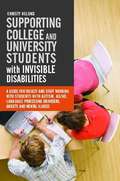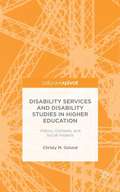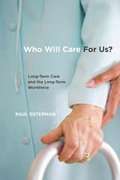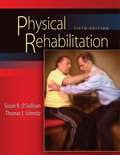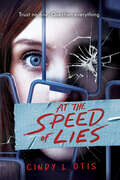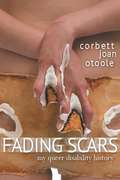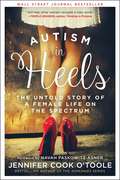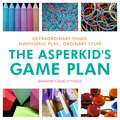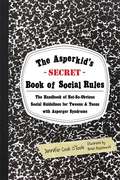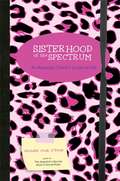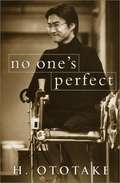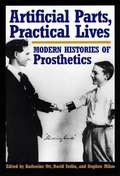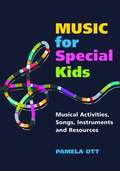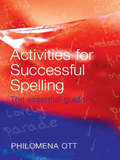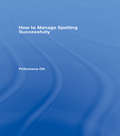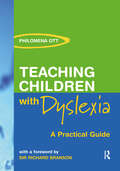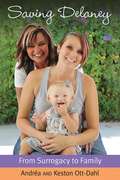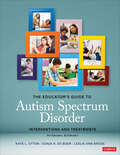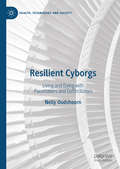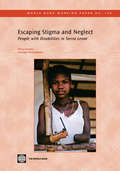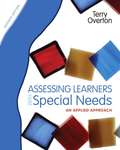- Table View
- List View
Supporting College and University Students with Invisible Disabilities: A Guide for Faculty and Staff Working with Students with Autism, AD/HD, Language Processing Disorders, Anxiety, and Mental Illness
by Christy OslundWith increasing numbers of students with invisible disabilities attending college and university, faculty and staff find themselves faced with new challenges. This practical handbook provides lecturers, tutors, disability services, and administrative staff with an overview of the invisible disabilities they may encounter, dispelling common myths and offering practical advice to support the needs of these students. Students with invisible disabilities are often academically talented but struggle with certain aspects of higher education such as keeping track of appointments or maintaining concentration in lecture halls. By providing detailed information on a range of disabilities including autism, AD/HD, dyslexia, OCD, and affective disorders, this book facilitates a better understanding of the unique needs of these students and what their strengths and limitations may be. With ideas for adapting teaching methods, offering suitable accommodations, and improving institutional policy, this is vital reading for all university faculty and staff.
Disability Services and Disability Studies in Higher Education: History, Contexts, and Social Impacts
by Christy M. OslundChristy Oslund explores how the divide between disability studies and disability services, which exist on college and university campuses everywhere, impacts students with disability on campus.
Developing Early Communication, Language and Learning Skills at Home: Creating Personalised Activity Packs for Parents
by Laura Osman Heidi ManouchehriDeveloping Early Communication, Language and Learning Skills at Home is full of tried-and-tested, practical activities for children developing their communication, language and learning skills including those with special educational needs and disabilities. This book provides parents, teachers and therapists with a range of playful and engaging activities to consolidate and develop children’s language and communication skills at home and school. Organised into five areas, the resource includes motivating activities around the themes of outdoor activities, daily routines, messy play, games for turn-taking and games to encourage creativity and make sense of the world. Features include: • 50 activities, each with a list of equipment, instructions, top tips, key vocabulary and ideas for extending the activity next time • Symbol boards for each activity to support children’s understanding and experiences • Photocopiable sheets for ease of use • Guidance on how to tailor activities to the interests and needs of the child to produce a personalised activity pack • An activity checklist to help you maximise your interactions with the child • An activity log to record children’s responses and achievements With clear and easy-to-follow instructions, the activities are suitable for use with children who are non-verbal, still developing their early communication or children who are talking. This is an invaluable resource for teachers, teaching assistants or therapists to share relevant activities with parents, and can equally be used by parents as a stand-alone resource. Designed to support the transfer of learning from school to home, this book will empower anyone working with children with SEND to develop children’s communication, language and learning through playful interactions.
Who Will Care For Us? Long-Term Care and the Long-Term Workforce: Long-Term Care and the Long-Term Workforce
by Paul OstermanThe number of elderly and disabled adults who require assistance with day-to-day activities is expected to double over the next twenty-five years. As a result, direct care workers such as home care aides and certified nursing assistants (CNAs) will become essential to many more families. Yet these workers tend to be low-paid, poorly trained, and receive little respect. Is such a workforce capable of addressing the needs of our aging population? In Who Will Care for Us? economist Paul Osterman assesses the challenges facing the long-term care industry. He presents an innovative policy agenda that reconceives direct care workers’ work roles and would improve both the quality of their jobs and the quality of elder care. Using national surveys, administrative data, and nearly 120 original interviews with workers, employers, advocates, and policymakers, Osterman finds that direct care workers are marginalized and often invisible in the health care system. While doctors and families alike agree that good home care aides and CNAs are crucial to the well-being of their patients, the workers report poverty-level wages, erratic schedules, exclusion from care teams, and frequent incidences of physical injury on the job. Direct care workers are also highly constrained by policies that specify what they are allowed to do on the job, and in some states are even prevented from simple tasks such as administering eye drops. Osterman concludes that broadening the scope of care workers’ duties will simultaneously boost the quality of care for patients and lead to better jobs and higher wages. He proposes integrating home care aides and CNAs into larger medical teams and training them as “health coaches” who educate patients on concerns such as managing chronic conditions and transitioning out of hospitals. Osterman shows that restructuring direct care workers’ jobs, and providing the appropriate training, could lower health spending in the long term by reducing unnecessary emergency room and hospital visits, limiting the use of nursing homes, and lowering the rate of turnover among care workers. As the Baby Boom generation ages, Who Will Care for Us? demonstrates the importance of restructuring the long-term care industry and establishing a new relationship between direct care workers, patients, and the medical system.
Physical Rehabilitation (5th Edition)
by Susan B. O'Sullivan Thomas J. SchmitzThe text is designed to provide a comprehensive approach to the rehabilitation management of adult patients and is intended to serve as a primary textbook for professional-level physical therapy students, and as an important resource for practicing therapists as well as for other rehabilitation professionals.
At the Speed of Lies
by Cindy L. OtisTrust no one. Question everything.Quinn Calvet was supposed to be having an epic year. She had all kinds of plans with her best friend, Ximena, and sister, Ava, and to grow her following as an influencer on The Whine. Instead, Quinn finds herself third wheel to Ximena and her new boyfriend or getting ditched by Ava who has turned into an overachiever, obsessed with studying and joining every school club. It brings up Quinn's old feelings that her disability has her left behind. She tries to talk to Ava about it, but she's too busy with the newest club at school, Defend Kids, which is working frantically to help find two kids who were recently kidnapped from a nearby town.Suddenly, Defend Kids is all anyone is talking about, and whenever Quinn posts about them on The Whine, she gains tons of new followers and her posts go viral. As the club works to get the message out, more kids in the surrounding area go missing, but it seems like the police and the media aren't doing much about it. When two of Quinn's classmates are kidnapped, the dangers that Defend Kids is trying to fight become all too real.As Quinn and her friends search for the missing kids, tensions escalate at school, there's an uptick in bullying, and conspiracy theories abound. Before she knows it, Quinn and The Whine are at the center of it all, trying to find out what's really happening. Only the truth might be more deadly than anyone knows...
Fading Scars: My Queer Disability History
by Corbett Joan OtooleUncovering stories about disability history and life, OToole shares her firsthand account of some of the most dramatic events in Disability History, and gives voice to those too often yet left out. From the 504 Sit-in and the founding of the Center for Independent Living in Berkeley, to the Disability Forum at the International Woman's Conference in Beijing; through dancing, sports, queer disability organizing and being a disabled parent, OToole explores her own and the disability community's power and privilege with humor, insight and honest observations.<P><P> "Corbett Joan OToole's Fading Scars: My Queer Disabled History is like a song-an anthem, a lullaby, a ballad, a love lyric and a chant all at once. This book of essays chronicles one person's life, but also the 40 years that disability rights and disability justice shaped American history. Its first-person accounts of historical events, fierce focus on disabled identities, and consistently accessible language and structure make it unusual-perhaps even unique-among disability memoirs. Bursting with ideas, stories, and arguments, Fading Scars is a book in which experience accrues into knowledge and emerges through the written word as wisdom. Fading Scars combines razor-sharp organization with passages of lyrical beauty. It establishes a new standard, perhaps even the beginning of a new aesthetic, for disability writing." - Margaret Price, author of Mad at School: Rhetorics of Mental Disability and Academic Life.<P> "Illuminating disability history with clear and funny stories, this book builds a home where those of us who have lived on the sidelines can seek shelter." - Naomi Ortiz, Writer, Artist and Disability Justice Activist<P> "Fading Scars is a must read for those interested in disability community, activism, and scholarship." - Kim Nielsen, author of A Disability History of the United States (ReVisioning American History)
Autism in Heels: The Untold Story of a Female Life on the Spectrum
by Jennifer O'TooleThe face of autism is changing. And more often than we realize, that face is wearing lipstick.<p><p>Autism in Heels, an intimate memoir, reveals the woman inside one of autism’s most prominent figures, Jennifer O'Toole. <p><p>At the age of thirty-five, Jennifer was diagnosed with Asperger's syndrome, and for the first time in her life, things made sense. Now, Jennifer exposes the constant struggle between carefully crafted persona and authentic existence, editing the autism script with wit, candor, passion, and power. Her journey is one of reverse-self-discovery not only as an Aspie but--more importantly--as a thoroughly modern woman.<p><p>Beyond being a memoir, Autism in Heels is a love letter to all women. It’s a conversation starter. A game changer. And a firsthand account of what it is to walk in Jennifer's shoes (especially those iconic red stilettos).<p><p>Whether it's bad perms or body image, sexuality or self-esteem, Jennifer's is as much a human journey as one on the spectrum. Because autism "looks a bit different in pink," most girls and women who fit the profile are not identified, facing years of avoidable anxiety, eating disorders, volatile relationships, self-harm, and stunted independence. Jennifer has been there, too. Autism in Heels takes that message to the mainstream.From her own struggles and self-discovery, she has built an empire of empowerment, inspiring women the world over to realize they aren't mistakes. They are misunderstood miracles.
The Asperkid's Game Plan: Extraordinary Minds, Purposeful Play... Ordinary Stuff
by Jennifer Cook O'TooleThe Asperkid's Game Plan looks from the inside at the learning style of children with Asperger syndrome and explains how to introduce structured play that engages Asperkids and explicitly addresses ASD weaknesses while reinforcing ASD strengths. Showing how just about anything can be turned into an opportunity for learning and growth, the book is full of go-to ideas for making simple play equipment in the home or classroom and using it to develop core skills that Asperkids struggle with, from fine motor and social skills, to planning and organization. Whether it's origami math, fried marbles, or a bug's eye view scavenger hunt, every game, project, and idea in the book is explained with clear directions and learning objectives and illustrated with color photographs. Jennifer O'Toole's enthusiastic approach and fun lessons, based on Montessori principles, will inspire and motivate parents, educators, and therapists to make purposeful play a part of every Asperkid's day.
The Asperkid's (Secret) Book of Social Rules: The Handbook of Not-So-Obvious Social Guidelines for Tweens and Teens with Asperger Syndrome
by Jennifer Cook O'TooleThis book is meant for asperkids and offers insights into baffling social codes such as making and keeping friends, blending in versus standing out from the crowd, and common conversation pitfalls, provides inside information on over thirty social rules in bite-sized chunks that older children can enjoy and understand.
Sisterhood of the Spectrum: An Asperger Chick's Guide to Life
by Jennifer Cook O'Toole Anne-Louise RichardsSpectrum gals, ever wished you had a handbook to help navigate the confusing world of teenage girlhood? Look no further! Aspie-in-the-know, Jennifer Cook O'Toole provides just that with her inspirational guide to life for teenage girls with Asperger syndrome. Drawing on her own, real-life experiences rather than preaching from textbooks, she covers everything you need (and want!) to know, from body shapes and love interests to bullying, friendships and how to discover and celebrate your unique, beautiful self. With illustrations by an Aspie teen and inspirational quotes from well-known, female Aspie voices, including Temple Grandin, Rudy Simone, Robyn Steward, and Haley Moss, Sisterhood of the Spectrum is your perfect companion on the "yellow brick road" to womanhood. It will leave you empowered, informed and excited to be different.
No One's Perfect
by Hirotada Ototake Gerry HarcourtMemoir of a young Japanese man born with no arms or legs.
Artificial Parts, Practical Lives: Modern Histories of Prosthetics
by Katherine Ott David Serlin Stephen MihmThese essays are valuable first forays into the history of prosthetics. From the wooden teeth of George Washington to the Bly prosthesis, popular in the 1860s and boasting easy uniform motions of the limb, to today's lifelike approximations, prosthetic devices reveal the extent to which the evolution and design of technologies of the body are intertwined with both the practical and subjective needs of human beings. The peculiar history of prosthetic devices sheds light on the relationship between technological change and the civilizing process of modernity, and analyzes the concrete materials of prosthetics which carry with them ideologies of body, ideals, body politics, and culture. Simultaneously critiquing, historicizing, and theorizing prosthetics, Artificial Parts, Practical Lives lays out a balanced and complex picture of its subject, neither vilifying nor celebrating the merger of flesh and machine.
Activities for Successful Spelling: The Essential Guide
by Philomena OttThis highly practical activity workbook is linked to the core text How to Manage Spelling Successfully and has been designed to support dyslexic students practise the spelling strategies and methods recommended in that book. This activity book can be used separately, or as part of an integrated programme for building students' spelling skills at home or at school. Suitable for mainstream classrooms, pupils undertaking additional literacy support in small groups, and for one-to-one teaching of individuals with specific learning difficulties including dyslexia, this excellent resource contains activities suitable for use at different stages of development, and for use with adults as well as school students. Each section contains a range of multi-sensory activities, including word searches, simple crossword puzzles and dictation exercises. This is an essential classroom companion for anyone helping struggling spellers.
How to Manage Spelling Successfully
by Philomena OttReaders will find this practical and comprehensive guide to spelling invaluable. Day-to-day advice on how to help those with difficulties is underpinned by information on the development of the English language and its spelling rules with explanations of common language problems. Chapters cover: spelling processes teaching and learning phonics individual cognitive and learning styles assessing and monitoring spelling progress teaching strategies and techniques. This is an essential companion for teachers, SENCos, and dyslexia specialists alike, as well as anyone interested in spelling and language difficulties.
Teaching Children with Dyslexia: A Practical Guide
by Philomena OttTeaching Children with Dyslexia is essential reading for any teacher, Special Educational Needs Co-ordinator or teaching assistant who wants an insider's account of what dealing successfully with dyslexia entails.Written by one of the most well-regarded practitioners in the field with over twenty-five years' experience, this book is packed full with photocopiable exercises, activities and recommendations for resources, tests, teaching methods, advice and suggestions for strategies and techniques that are instantly transferable to classroom environments. This essential teaching companion includes chapters on: how to spot dyslexia screening and assessment tests why it does not have to be hell to learn to spell strategies for success for reluctant writers meeting the challenge of dyslexia in adolescence. Written specifically to bolster teachers' confidence and empower them with the key to unlocking literacy problems in their most challenging pupils, this resource book should be on the shelf of every staff room.
Saving Delaney: From Surrogacy to Family
by Keston Ott-DahlSaving Delaney is the heartwarming true story of a special needs baby and the unconventional family who fought for her right to life. Andrea Ott-Dahl, who with her wife Keston Ott-Dahl has two other children, agreed to act as a pregnancy surrogate for a wealthy Silicon Valley couple. When pre-natal testing revealed the baby would be born with Down Syndrome, Andrea was urged to abort the child. Instead, the Ott-Dahls chose to adopt and raise the daughter they would call Delaney, navigating legal, medical and emotional challenges. Despite heart surgery and an array of other challenges, Delaney at age 3 is alive, thriving, and an inspiration to every loving parent on the planet.
The Educator′s Guide to Autism Spectrum Disorder: Interventions and Treatments
by Kaye L. Otten Sonja R. de Boer Leslie Ann BrossIdentify the best interventions to fit the unique needs of each learner with autism Whatever your role—general or special education teacher, school counselor, therapist, behavior analyst, administrator—you undoubtedly interact with learners with autism spectrum disorder (ASD) and are committed to helping them succeed and thrive. This easy-to-use accessible guide summarizes more than 75 interventions and rates each based on the most recent evidence of effectiveness and safety. Features include: A summary of interventions and treatments from a comprehensive variety of domains organized into 11 categories, including behavioral interventions, visual supports, social and emotional skills training, and physiological interventions, as well as interventions that have the potential for causing harm An evidence-based five-point scale that clearly rates each intervention’s effectiveness for specific learners Guidance for working with colleagues and families to choose and implement the most promising treatments Written by educators with decades of experience and expertise in a variety of settings, many of whom are also Board Certified Behavior Analysts, this comprehensive guide is an indispensable resource for all those who serve students with ASD.
The Educator′s Guide to Autism Spectrum Disorder: Interventions and Treatments
by Kaye L. Otten Sonja R. de Boer Leslie Ann BrossIdentify the best interventions to fit the unique needs of each learner with autism Whatever your role—general or special education teacher, school counselor, therapist, behavior analyst, administrator—you undoubtedly interact with learners with autism spectrum disorder (ASD) and are committed to helping them succeed and thrive. This easy-to-use accessible guide summarizes more than 75 interventions and rates each based on the most recent evidence of effectiveness and safety. Features include: A summary of interventions and treatments from a comprehensive variety of domains organized into 11 categories, including behavioral interventions, visual supports, social and emotional skills training, and physiological interventions, as well as interventions that have the potential for causing harm An evidence-based five-point scale that clearly rates each intervention’s effectiveness for specific learners Guidance for working with colleagues and families to choose and implement the most promising treatments Written by educators with decades of experience and expertise in a variety of settings, many of whom are also Board Certified Behavior Analysts, this comprehensive guide is an indispensable resource for all those who serve students with ASD.
Resilient Cyborgs: Living and Dying with Pacemakers and Defibrillators (Health, Technology and Society)
by Nelly OudshoornThis book examines how pacemakers and defibrillators participate in transforming life and death in high-tech societies. In both popular and medical accounts, these internal devices are often portrayed as almost magical technologies. Once implanted in bodies, they do not require any ‘user’ agency. In this unique and timely book, Nelly Oudshoorn argues that any discourse or policy assuming a passive role for people living with these implants silences the fact that keeping cyborg bodies alive involves their active engagement. Pacemakers and defibrillators not only act as potentially life-saving technologies, but simultaneously transform the fragility of bodies by introducing new vulnerabilities. Oudshoorn offers a fascinating examination of what it takes to become a resilient cyborg, and in the process develops a valuable new sociology of creating ‘resilient’ cyborgs.
Bioethics and Disability
by Alicia OuelletteBioethics and Disability provides tools for understanding the concerns, fears, and biases that have convinced some people with disabilities that the health care setting is a dangerous place and some bioethicists that disability activists have nothing to offer bioethics. It wrestles with the charge that bioethics as a discipline devalues the lives of persons with disabilities, arguing that reconciling the competing concerns of the disability community and the autonomy-based approach of mainstream bioethics is not only possible, but essential for a bioethics committed to facilitating good medical decision making and promoting respect for all persons, regardless of ability. Through in-depth case studies involving newborns, children, and adults with disabilities, Bioethics and Disability proposes a new model for medical decision making that is both sensitive to and sensible about the fact of disability in medical cases. Disability-conscious bioethics will bring together disability experts and bioethicists to identify and mitigate disability bias in our health care systems.
Escaping Stigma and Neglect: People with Disabilities in Sierra Leone
by Mirey Ovadiya Giuseppe ZampaglionePeople with disabilities in Sierra Leone are disadvantaged in regards to their access to social services and the economic opportunities available to them. Oftentimes, they are marginalized and their rights are ignored. The government of Sierra Leone is taking measures to improve the social and economic situation of people with disabilities in the country. The objective of this note on people with disabilities in Sierra Leone is to: (i) provide a diagnosis on the scale and nature of the problem, (ii) analyze current public policies in support of people with disabilities, (iii) review public and private programs, and (iv) propose policy options to policy makers and development partners. It is meant for policy makers and practitioners in Sierra Leone as well as all those interested in the subject.
Technology for All Assistive Technology in the Classroom
by Overbrook School for the BlindAn easy-to-read, field tested resource for all schools and colleges that need assistive technology in the classroom.
Assessing Learners With Special Needs: An Applied Approach (Seventh Edition)
by Terry OvertonAssessing Learners with Special Needs: An Applied Approach, seventh edition, is a practical book designed to teach you about the complex procedures of the assessment process. Each chapter starts out with a chapter focus that contains CEC Knowledge and Skills Standards that show you what you are expected to master in the chapter. Concepts are presented in a step-by-step manner followed by exercises that help you understand each step. Portions of assessment instruments, protocols, and scoring tables are provided to help you with the practice exercises. Additionally, you will participate in the educational decision-making process using data from classroom observations, curriculum-based assessment, functional behavior assessment, and norm-referenced assessment. New to the seventh edition: An emphasis on progress monitoring, including progress monitoring applied to the acquisition of knowledge and skills presented in this text The assessment process according to the regulations of IDEA 2004 A separate chapter on transition issues and assessment A separate chapter on assessment in infancy and early childhood A new chapter on the measurement aspects of Response to Intervention Increased consideration of students from culturally and linguistically diverse backgrounds in the assessment process
